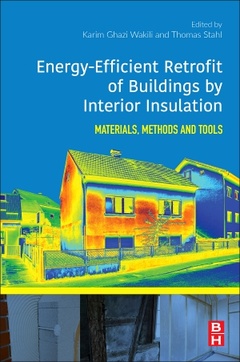Description
Energy-Efficient Retrofit of Buildings by Interior Insulation
Materials, Methods, and Tools
Language: English
518 p. · 15.2x22.8 cm · Paperback
Description
/li>Contents
/li>Biography
/li>Comment
/li>
Energy-Efficient Retrofit of Buildings by Interior Insulation: Materials, Methods and Tools offers readers comprehensive coverage of current research in German Language Countries. Chapters provide an overview on the development of energy efficiency for building retrofits and the role of internal insulation, cover materials with chapters on Brick, Wood, Plaster, Clay, and Natural Stone, explain the impact of internal insulation in those materials and how to cope with problems such as moisture build, mold and algae growth, provide practical advice on how to apply internal insulation in the most effective way, including Salt Efflorescence, Noise Protection, Fire Prevention, and more.
The practical approach of the book, with examples in all chapters, makes it valuable for Civil and Architectural Engineers involved with building retrofit. The book may also be useful to researchers in the field of Building Physics due to the breadth of the coverage.
Section 1: Materials 1.1. Materials (wood, concrete, brick, natural stones, renewables) 1.2. Peculiarities of using VIP as internal insulation 1.3 Hydrophilic and hydrophobic materials as internal insulations for historic masonry walls 1.4 Historical plasters in connection with thermal insulations 1.5 Advantages and use of a newly developed load-bearing insulation material made of cattail 1.6 Hygric interactions with antigraffiti systems 1.7 Insulating plasters and their use as internal insulation
Section 2: Measurements and Procedures 2.1 Restoration of moisture and salt damaged masonry 2.2 Status analysis and building diagnosis prior to the application of internal insulation; practical implementation of the results obtained; some examples 2.3 Influence of internal thermal insulation on the sound insulation of walls 2.4 Peculiarities of installing internal insulation in half-timbered walls; detailed solutions; some examples 2.5 In situ measurement of water uptake on facades and its correspondence with internal insulation materials 2.6 Holistic and process approach to internal insulation 2.7 Peculiarities of fire protection in case of internal insulation; fire prevention and fire protection concepts; some examples 2.8 Variations and design options in renovation with internal insulation 2.9 Internally insulating building details in contact with the ground 2.10 Mitigation of structural thermal bridges 2.11 Energy-efficient renovation with internal insulation
Section 3: Simulation and Analysis Tools 3.1 Case study: Near zero energy building 3.2 Hygrothermal behavior of internal insulation systems with component integrated heating elements 3.3 Interior insulation and mold problems 3.4 Comparison of different internal thermal insulation materials with respect to their hygrothermal behavior 3.5 Energy performance evaluation of internal insulation as a measure for the modernization of existing buildings
Karim Ghazi Wakili obtained his MS degree in experimental physics as well as his PhD from the Swiss Federal Institute of Technology (ETHZ) in Zurich Switzerland. He joined the Swiss Federal Laboratories for Materials Science and Technology (Empa) as member of the scientific staff, group leader and finally Senior Scientist in the former Laboratory for Building Physics where he served over a total period of 26 years. Since 2016 he is co-founder and managing director of the Institute for Applied Building Physics (IABP) in Winterthur Switzerland and has also a partial affiliation with the Bern University of Applied Sciences.
His area of research and expertise includes heat and mass transfer in porous building materials at ambient and fire temperatures as well as the corresponding numerical simulations and experimental techniques. He is member of the editorial board of “Energy and Buildings, “Advances in Building Energy Research and “Buildings.
- Introduces methods and tools through application examples
- Presents theory and simulations with practical information to validate models
- Explores a wide variety of materials and applications
- Features examples of Residential, Commercial and Historic Buildings
- Covers all stages of the retrofit process, from planning to inspection and how to avoid damage




